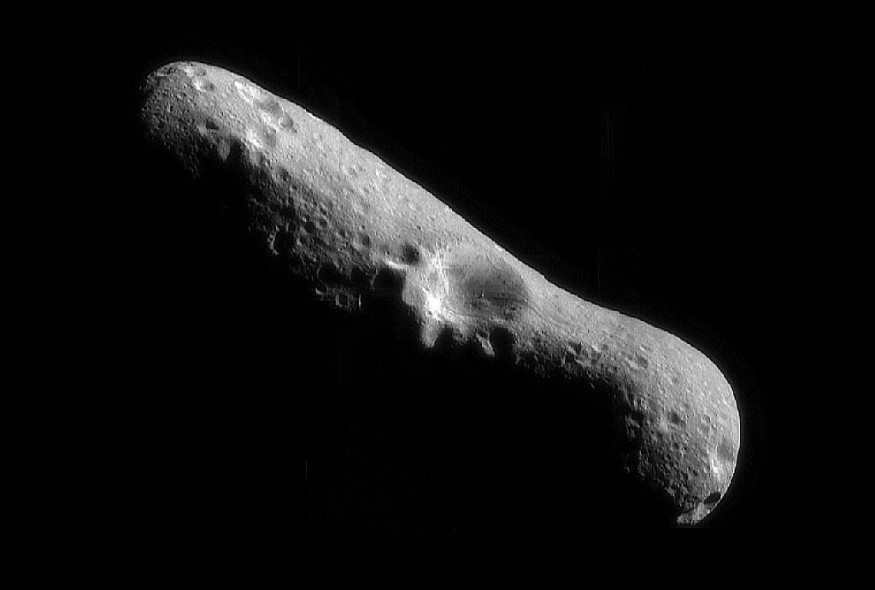NASA is now watching an asteroid that is roughly three times the size of the London Eye as it approaches Earth.
The space agency detected the asteroid dubbed 'Monster Planet Killer' and said the massive space rock would approach Earth very soon.
Reports said this massive meteorite, dubbed 2013 BO76, has the potential to destroy the entire city if it collides with any area of it.
Virtual Telescope said this possibly deadly asteroid would pass relatively close to Earth at 5.1 million kilometers, or nearly 13 times the standard lunar distance.

A mosaic image of asteroid Eros at its north pole, taken by the robotic NEAR Shoemaker space probe February 14, 2000 immediately after the spacecraft's insertion into orbit.
NASA Braces For Asteroid 2013 BO76
Asteroid 2013 BO76, a large space rock between 600 and 1500 feet, will pass close to Earth on March 24.
According to the Daily Star, PanSTARRS survey found the object on Jan. 17, 2013.
Virtual Telescope Project found the space rock on March 7 while it was still 15 million miles away from Earth.
Next week, at its closest approach, it will pass within three million kilometers of the Earth.
It's far enough away from the Earth's surface to avoid crashing with it, but it's a close call in terms of astronomy.
However, NASA experts are constantly watching the meteorite because of the potential for catastrophe. It is due to the possibility of a collision due to Earth's gravity.
How NASA Classifies Near-Earth Object's Threat
Big Think explained that a near-Earth object is considered a threat by astronomers if it comes within 4.6 million miles (7.4 million kilometers) of the planet and has a diameter of at least 460 feet (140 meters).
If a celestial body of this magnitude collided with Earth, it might wipe out cities and devastate entire regions.
Larger objects - those measuring 1 km (0.6 miles) or more - might have global consequences and perhaps result in mass extinctions.
A 10-km (6-mile) diameter asteroid collided with what is now the Yucatán Peninsula 65 million years ago, causing the most renowned and deadly collision.
It wiped out most of Earth's plant and animal species, including the dinosaurs.
Smaller things, on the other hand, might inflict severe harm. In 1908, an estimated 50-meter (164-foot) celestial object burst over the Tunguska river in Siberia.
It destroyed nearly 80 million trees across 2,100 square km (830 square miles).
An asteroid measuring about 65 feet (20 meters) in diameter exploded in the sky 32 kilometers (20 miles) over Chelyabinsk, Russia, in 2013.
It ejected enough energy to detonate 30 Hiroshima bombs, injuring over 1,100 people and causing US$33 million in damage.
Asteroid 2005 ED224 is the next giant asteroid that might collide with Earth.
The 164-foot (50-meter) asteroid will fly by on Mar. 11, 2023, with a 1 in 500,000 probability of colliding.
What Space Agency Planned For These Catastrophes
Early detection is critical for protecting the world from cosmic threats.
Scientists at the 2021 Planetary Defense Conference (via The Conversation) indicated that a successful defense against dangerous asteroids needs at least five to 10 years of planning.
There are four strategies to avoid a calamity if astronomers discover a harmful asteroid.
The first is a set of regional first-aid and evacuation protocols. A second option would be to deploy a spacecraft near a tiny or medium-sized asteroid.
The craft's gravity would gradually shift the asteroid's orbit. We can either smash something into it at high speeds or explode a nuclear bomb nearby to modify the route of a giant asteroid.
The Double Asteroid Redirection Test, or DART, was launched by NASA in November 2021 as a proof of concept for the world's first full-scale planetary defense mission.
Didymos, a huge asteroid, and its tiny moon pose no threat to Earth at this time.
NASA aims to alter the asteroid's orbit in September 2022 by slamming a 1,340-pound (610 kg) probe into Didymos' moon at a speed of around 14,000 mph (22,500 kph).
RELATED ARTICLE : Space Events, Discoveries From the Past Week Offers Glimpse of the Cosmos for Future Explorations
Check out more news and information on Space in Science Times.












